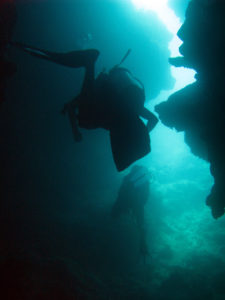Cave diving is one of the most extreme sports out there. If you thought that regular scuba diving was extreme, then get ready, because cave diving blows it out of the water… pun intended.
Why is cave diving risky?
Cave diving may involve similar actions to regular diving, but there is more to it than just that. For instance, cave diving is considered as a type of technical diving, which can be much more dangerous and even deadly than the risks that one would face in recreational diving.
This is why cave diving should never be attempted by anyone who does not at least have a good grasp of open-water diving and have a cave diving certificate. Cave diving lessons are specialized to cave diving itself, as everything taught, from the environment to even the equipment itself, is done so with cave diving specifically in mind. This means that something you learned to do in a regular diving session may not necessarily mean it is something you should do in cave diving as well.
What are the risks that one can find in cave diving?
Being a sport even more extreme than recreational scuba diving, cave diving has a lot of risks involved, some it shares with other diving activities, others unique to itself.
Visibility- You probably already know that caves, especially the ones that get really deep, are very dark. They receive no light other than the ones that your equipment produces, so you have a lot less to work with. Scuba divers normally don’t have to worry about this as most of them dive during the day, when there is a lot of light penetrating the water. Some people might try night diving there as well, but it can get risky, especially without light.
For cave diving, not only do you need proper light equipment to actually see where you’re going, you need to be careful while you swim. Again, going back to earlier, with cramped spaces and rocky environments, you can end up hitting things you don’t want to hit. A kick in the wrong direction can send silt, soil, and sediment flying all around your face, making you lose massive visibility and just being dangerous all around.
Difficulty in surfacing- You can probably wager the layout of an underwater cave. After all, it really is just a regular cave filled to the brim with water. This means that it shares the environment of a cave, such as how cramped spaces can get depending on the formation of rocks and walls underwater. This can be inconvenient or even dangers, because if you aren’t careful, you may end up hitting one of these spots and end up injuring yourself.
But let’s take it one step further. When you need to surface in any other type of diving, you can simply do so. In open-water diving, for instance, the only thing that might block your ascent from the sea is the boat that you jumped out of earlier.
Not so when it comes to cave diving. As mentioned earlier, you are restrained in your movement depending on how large the underwater cave is, but the thing most concerning is the overhead environment preventing a cave diver from just surfacing immediately during an emergency. Some parts of the ceiling may end up submerged while you’re deep underwater, which means that you will need to find your way to an actual suitable place that you can surface before you can actually surface on the water. If you try to surface wherever, you’re more than likely to hit your head on the rocky ceiling instead. Since you are unable to just surface wherever, you will need to spend time to actually find a way up, and if you didn’t pay attention to where you were, you may end up getting lost. That is not something you want happening, especially in an already dangerous situation.
It is basically the complete opposite of scuba diving. Scuba diving has a large area where you can surface, with a small area that you should avoid (the boat). In comparison, cave diving has a large area that you can’t surface, with only a small area that you can actually surface.
Air supply- Something that divers from all over must watch, and not something unique to cave diving. Depending on the environment, one’s air consumption can vary wildly. In cave diving, this might increase, due to it being a high-stress environment. Ideally you would remain calm underwater, but conditions in such areas are not stable and can change randomly at any time, potentially causing panic for an unprepared individual.
Ideally one is always prepared for the worst and has a plan ready just in case, even if it does not happen.
Equipment troubles- Again, something not unique to cave diving, but more dangerous when it happens during cave diving. Things like masks breaking, torches flooding, or reels tangling are something that a diver must be prepared for and should be handled calmly when the situation arises, so as to not make things worse.

